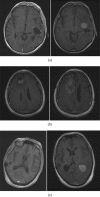Patterns of relapse in glioblastoma multiforme following concomitant chemoradiotherapy with temozolomide
- PMID: 23385995
- PMCID: PMC3608050
- DOI: 10.1259/bjr.20120414
Patterns of relapse in glioblastoma multiforme following concomitant chemoradiotherapy with temozolomide
Abstract
Objective: Different methods for contouring target volumes are currently in use in the UK when irradiating glioblastomas post operatively. Both one- and two-phase techniques are offered at different centres. 90% of relapses are recognised to occur locally when using radiotherapy alone. The objective of this evaluation was to determine the pattern of relapse following concomitant radiotherapy with temozolomide (RT-TMZ).
Methods: A retrospective analysis of patients receiving RT-TMZ between 2006 and 2010 was performed. Outcome data including survival were calculated from the start of radiotherapy. Analysis of available serial cross-sectional imaging was performed from diagnosis to first relapse. The site of first relapse was defined by the relationship to primary disease. Central relapse was defined as progression of the primary enhancing mass or the appearance of a new enhancing nodule within 2 cm.
Results: 105 patients were identified as receiving RT-TMZ. 34 patients were not eligible for relapse analysis owing to either lack of progression or unsuitable imaging. Patterns of first relapse were as follows: 55 (77%) patients relapsed centrally within 2 cm of the original gadolinium-enhanced mass on MRI, 13 (18%) patients relapsed >4 cm from the original enhancement and 3 (4%) relapsed within the contralateral hemisphere.
Conclusion: Central relapse remains the predominant pattern of failure following RT-TMZ. Single-phase conformal radiotherapy using a 2-cm margin from the original contrast-enhanced mass is appropriate for the majority of these patients.
Advances in knowledge: Central relapse remains the predominant pattern of failure following chemoradiotherapy for glioblastomas.
Figures


Similar articles
-
Phase I study of hypofractionated intensity modulated radiation therapy with concurrent and adjuvant temozolomide in patients with glioblastoma multiforme.Radiat Oncol. 2013 Feb 20;8:38. doi: 10.1186/1748-717X-8-38. Radiat Oncol. 2013. PMID: 23425509 Free PMC article. Clinical Trial.
-
Radiotherapy with and without temozolomide in elderly patients with glioblastoma.Strahlenther Onkol. 2012 Feb;188(2):154-9. doi: 10.1007/s00066-011-0026-7. Epub 2012 Jan 11. Strahlenther Onkol. 2012. PMID: 22231634
-
The value of temozolomide in combination with radiotherapy during standard treatment for newly diagnosed glioblastoma.J Neurooncol. 2013 Apr;112(2):277-83. doi: 10.1007/s11060-013-1060-3. Epub 2013 Feb 2. J Neurooncol. 2013. PMID: 23377829
-
Hypofractionated radiotherapy with or without concurrent temozolomide in elderly patients with glioblastoma multiforme: a review of ten-year single institutional experience.J Neurooncol. 2012 Apr;107(2):395-405. doi: 10.1007/s11060-011-0766-3. Epub 2011 Nov 22. J Neurooncol. 2012. PMID: 22105851 Review.
-
Therapeutic interactions of autophagy with radiation and temozolomide in glioblastoma: evidence and issues to resolve.Br J Cancer. 2016 Mar 1;114(5):485-96. doi: 10.1038/bjc.2016.19. Epub 2016 Feb 18. Br J Cancer. 2016. PMID: 26889975 Free PMC article. Review.
Cited by
-
Recurrence patterns in patients with high-grade glioma following temozolomide-based chemoradiotherapy.Mol Clin Oncol. 2016 Aug;5(2):289-294. doi: 10.3892/mco.2016.936. Epub 2016 Jun 15. Mol Clin Oncol. 2016. PMID: 27446566 Free PMC article.
-
The Definition and Delineation of the Target Area of Radiotherapy Based on the Recurrence Pattern of Glioblastoma After Temozolomide Chemoradiotherapy.Front Oncol. 2021 Feb 22;10:615368. doi: 10.3389/fonc.2020.615368. eCollection 2020. Front Oncol. 2021. PMID: 33692942 Free PMC article.
-
The Nomogram Model Predicting Overall Survival and Guiding Clinical Decision in Patients With Glioblastoma Based on the SEER Database.Front Oncol. 2020 Jun 26;10:1051. doi: 10.3389/fonc.2020.01051. eCollection 2020. Front Oncol. 2020. PMID: 32676458 Free PMC article.
-
Characterizing the Genomic Profile in High-Grade Gliomas: From Tumor Core to Peritumoral Brain Zone, Passing through Glioma-Derived Tumorspheres.Biology (Basel). 2021 Nov 9;10(11):1157. doi: 10.3390/biology10111157. Biology (Basel). 2021. PMID: 34827152 Free PMC article.
-
Examination of sulfonamide-based inhibitors of MMP3 using the conditioned media of invasive glioma cells.J Enzyme Inhib Med Chem. 2020 Dec;35(1):672-681. doi: 10.1080/14756366.2020.1715387. J Enzyme Inhib Med Chem. 2020. PMID: 32156166 Free PMC article.
References
-
- Stupp R, Mason WP, Van denBent MJ, Weller M, Fisher B, Taphoorn MJ, et al. Radiotherapy plus concomitant and adjuvant temozolomide for glioblastoma. N Engl J Med 2005;352:987–96 - PubMed
-
- Stupp R, Hegi ME, Mason WP, Van denBent MJ, Taphoorn MJ, Janzer RC, et al. Effects of radiotherapy with concomitant and adjuvant temozolomide versus radiotherapy alone on survival in glioblastoma in a randomized phase III study: 5-year analysis of the EORTC-NCIC trial. Lancet Oncol 2009;10:459–66 - PubMed
-
- Burger PC, Dubois PJ, Schold C, Smith KR, Odum GL, Crafts DC, et al. Computerized tomographic and pathologic studies of the untreated, quiescent, and recurrent glioblastoma multiforme. J Neurosurg 1983;58:159–69 - PubMed
-
- Halperin EC, Bentel G, Heinz ER, Burger PC. Radiation therapy treatment planning in supratentorial glioblastoma multiforme: an analysis based on post mortem topographic anatomy with CT correlations. Int J Radiat Oncol Biol Phys 1989;17:1347–50 - PubMed
MeSH terms
Substances
LinkOut - more resources
Full Text Sources
Other Literature Sources
Medical

